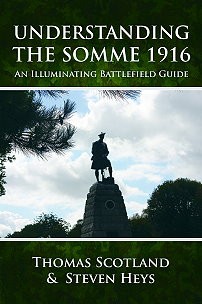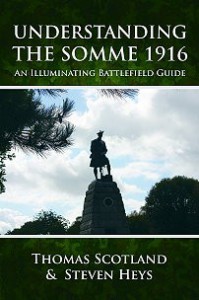Battlefield guide books!? We didn’t use guide books on the Somme in ma day lad, we just got on with it and found out for us selves… Well, alright, we had a map and had done a huge amount of background reading beforehand.
It seems that the authors could not make up their mind whether to write a book about the first day of the Somme Campaign 1916, the whole campaign of 1916 or a touring guide book. Speaking as one, who like so many, has visited the Somme Battlefield countless times; driven it and walked it, I can say that as a guide book the directions to the major sites on the battlefield are fine. In short, if you are in need of directions to find your way around the area then this book does the job. Ask yourself the question, do you want a travel guide book to the Somme 1916? If you are the kind of person who wouldn’t need a guide book then there is no point in reading on.
Thomas Scotland and Steven Heys’ book is an armchair guide and there is a market for this type of book. Many people go out to the Somme who are keen either to simply see it or find out where Great Uncle Tom died and then visit the grave or memorial. Some want to experience it, some want to ‘do it’ … All good stuff. A guide book would be very useful to them. Doing a tour of the Somme in a few, short days is quite a task that can leave one baffled, particularly for the first time. Therefore a guide like this can be handy. When you go out to the Somme for the first time and you read about 1 July 1916 for the first time you can’t help but be stunned by the events of the first day. But one has to remember that there were many other days on the Somme.
Scotland and Heys’ book is very heavily influenced by the events of the first day. Who can blame them? It is seemingly a national obsession. The pieces that deal with the rest of the campaign that continued until November 1916 are scant. Nor is the book comprehensive. Where are the 17th (Northern) Division? In this work Major-General Robertson’s division is absent. You would be forgiven for believing that they weren’t there. The 38th Division could not have taken Mametz Wood without operations by the 17th Division, no matter who commanded them, Phillips, Watts or Blackader (not a spelling mistake). The German Army is mentioned occasionally but if one is to do an analysis that allows the reader to understand the Somme, 1916, then they too would have to be researched and their deeds, stratagems and actions examined in the text. If one is going to make the claim that the book will enable the reader to understand the Somme then all aspects of the campaign have to be examined.
It is good to see that some of the orders of battle have been included and they are useful for understanding which unit belonged to which higher formation. Have a care with Regular and Kitchener New Army divisions. Undeniably this was the first big ‘show’ for the New Army divisions but one must remember that the Regular divisions had been re-enforced by volunteers. Despite their time on the front line these formations were made up of many novices in July 1916.
The photographs are interesting. Some ‘then and now’ picture sets would have been useful but I do know that the cost of Imperial War Museum images for publication is very high. Can I make a point about the photograph of the headstone on page sixty-six? It is adorned by an Australian or New Zealand flag, a laminated piece of text and a photograph. The caption speaks emotionally of a message from a relative to the man in the grave. I am not being sniffy, the sentiment and the emotion is genuine and the act of adorning the grave well meant. Personally, I don’t think that we need flags planting on the graves, it does make them look undignified; like sandcastles on the beach. The cemeteries are really so well kept that they don’t need spoiling. The Commonwealth War Graves Commission’s line on this is that floral tributes are fine, which will be removed once they have faded and obviously there is no issue with poppy crosses or poppy wreathes. They ask that no tribute left is permanent.
It is a brave thing to do, to imply that the book will enable the reader to understand the Somme. Particularly when one considers who is out there, Bourne, Hart, Sheffield, Sheldon and Simkins to name a few and all with views about the Somme Campaign. It could be a little bit like popping ones head over the parapet on 7 July 1916 (in the 17th Division’s sector) and shouting “Hey, Fritz, over here!” However, I never let that bother me, so good effort for having a go! Scotland and Heys have put a good deal of hard work into this guide book and that shows. It is well written and the main episodes of the Campaign are all there, divided into seventeen chapters. Helion have done a good production job on the book, it is glossy and the photographs are in colour. There is a select bibliography and a good index, plus a few maps.
A couple of friends, one who has visited the Somme once and the other who is due to go, looked at it and said, “Very nice, well put together, I’d be frightened of dropping it in the mud. Give me a map any day.” Another said, “Yes, but do you really understand the Somme after reading it?” No, not really. In the final analysis would I buy it; no but then, I’m not the target readership. Would I recommend it to someone wishing to visit the Somme for the first time? Yes, but I would still suggest that if they were really interested in the events of the Somme Campaign that they read around the subject before going. Buying the guide and putting it in the glove box would do no harm and the directions would be very handy.
Reviewed by Dr Wayne Osborne for War History Online
Understanding The Somme 1916. An Illuminating Battlefield Guide.
UNDERSTANDING THE SOMME 1916
An Illuminating Battlefield Guide
By Thomas Scotland and Steven Heys
Helion & Co
ISBN 978 1 909384 42 2

